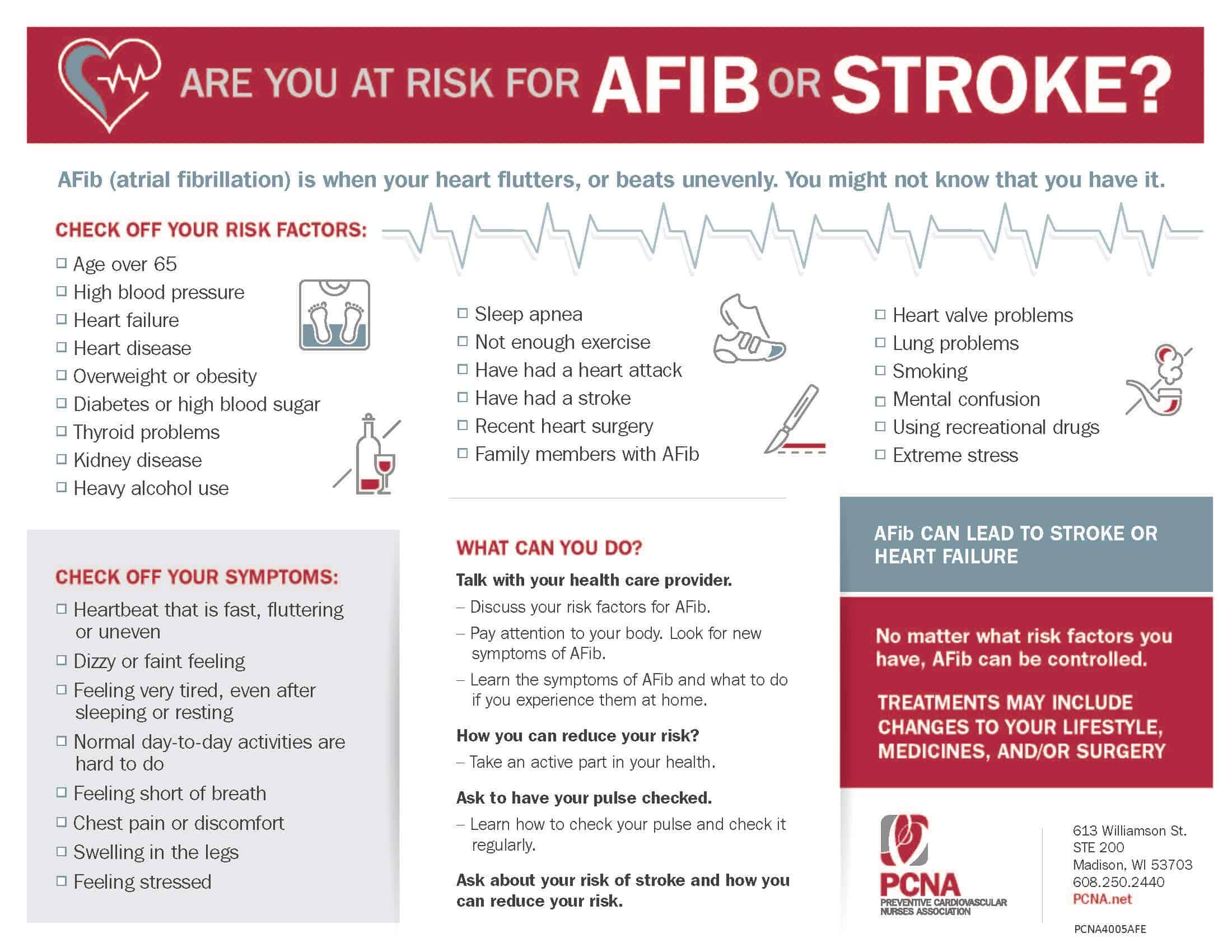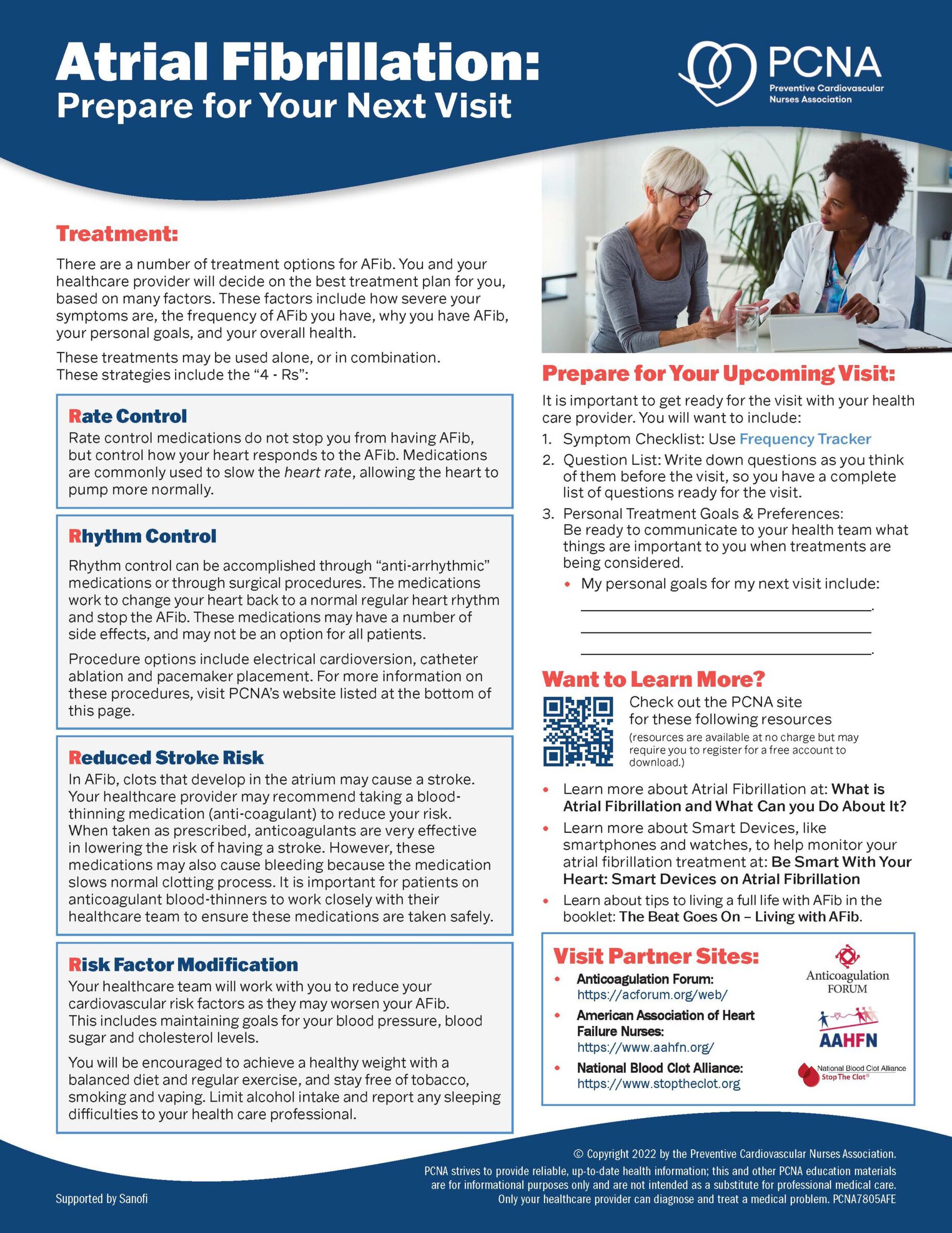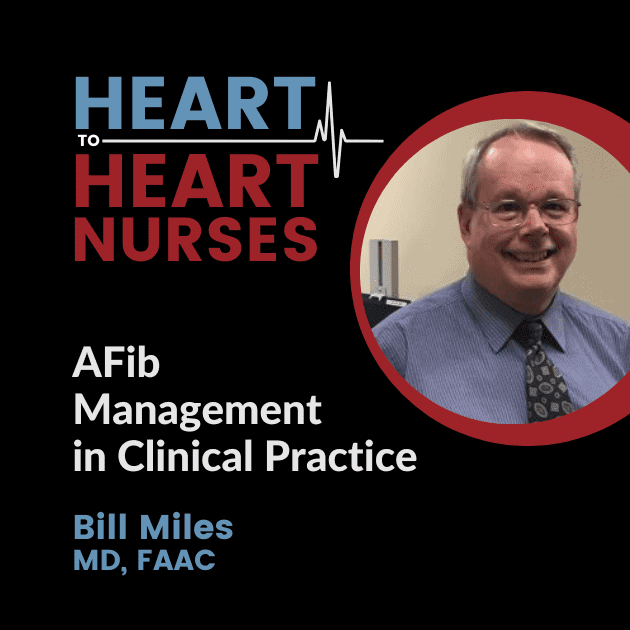Atrial fibrillation (AFib) management includes both pharmacologic and non-pharmacologic therapies. Guest Bill Miles, MD, FACC, of the University of Florida, Gainesville, describes how to effectively treat AFib–from asymptomatic younger patients without left ventricular dysfunction to older patients with significantly reduced ejection fraction.
Episode Resources
Welcome to Heart to Heart Nurses, brought to you by the Preventive Cardiovascular Nurses Association. PCNA’s mission is to promote nurses as leaders in cardiovascular disease prevention and management.
Geralyn Warfield (host): It is an honor today to have the chance to discuss atrial fibrillation with Dr. William Miles, and Dr. Miles, would you like to introduce yourself to our audience?
Bill Miles (guest): Yeah, my name’s Bill Miles and I’m Professor of Medicine at the University of Florida in Gainesville, a Program Director for Cardiac Electrophysiology. So, I do a lot of training with the, with the fellows and the young people. It keeps me young.
Geralyn Warfield (host): That’s wonderful. So, you have some experience with AFib, which is a very complex kind of topic for us to actually discuss in such a short amount of time. But we’re going to focus in, if you won’t mind, on the general approach to the patients who were, a patient who presents with AFib, the underlying [00:01:00] causes, anticoagulation, rate and rhythm control. Would you mind launching into some information for our audience on that?
Bill Miles (guest): Yeah. So, there’s some generalities about AFib that might be, that might be useful. Two major things that you have to think about when you’re presented with an AFib patient are why does this patient have atrial fib? And then how are you going to manage the atrial fib?
And in the old days, why does the patient have atrial fib was sort of easy, because we didn’t know very much. And we always did a very simple workup. We did a thyroid test because a few of these people would have hyperthyroidism, that if you treated, the AFib would go away or get significantly better. And we’d do an echocardiogram to look at cardiac valve function and cardiac muscle function, looking for things that are structurally wrong with the heart that might be stressing the atrium and causing the atrial fib.
But now [00:02:00] we’re learning more and more things that also intersect with other areas of cardiology, that are critically important in the etiology of atrial fib, and also critically important if you have atrial fib, they can make that atrial fib much more refractory to therapy and occur much more often.
The one we really deal with a lot now, and ask every atrial fib patient, is we ask them about sleep. Because obstructive sleep apnea is found in a large percentage of atrial fib patients. If you have sleep apnea, you’re much more likely to have atrial fib than if you don’t. And if you’re trying to manage atrial fib, whether you’re using drugs or whether you’re using ablation, you can get better results if you simultaneously send that patient to a sleep specialist and get their sleep apnea managed. Maybe, not even simultaneously. It might be better to send them [00:03:00] there first, and then do the ablation, if that’s what you’re going to do. And your ablation results might look better from that.
We’re also learning that other lifestyle-type things—like obesity and diabetes and that sort of thing—management of those things makes atrial fib easier to manage. And lastly, we know that alcohol seems to be a big trigger for atrial fib. So down in Florida, where everyone likes to be on their golf cart and, and drink as they do their golf game, it’s sometimes hard to talk to them about cutting down or stopping alcohol. But we talked to them around the time of an AFib ablation that, if you could do no alcohol, at least in the few months after an AFib ablation, and let the atrium get used to the normal rhythm, then you [00:04:00] may do much better in the long term. Then we, so, those are sort of the etiologies of atrial fib. There’s more that we can change than we used to think. And changing those things also make your general cardiac health better.
Managing atrial fib comes down to the old classic threesome. So, there are three things that we’ve taught fellows for ages on how to manage atrial fib. And the first one is prevention of thromboembolism. So, prevention of stroke is critical. And in fact, if you forget about everything else, prevention of stroke is the number one thing with atrial fib. So as most of your listeners probably know there’s a scoring system that we use called the CHA2DS2-VASc system, that takes age and previous stroke and gender and heart failure, and hypertension and diabetes into consideration. And with [00:05:00] certain scores you should be anticoagulated.
And the new guidelines, or update of the guidelines that came out in 2019, even say that the preferred anticoagulants in these patients are now these new direct-acting oral anticoagulants, such as apixaban or rivaroxaban or dabigatran. So, so that that’s really the linchpin of, of prevention of stroke.
There are some other fancier things like left atrial appendage occlusion, or left atrial appendage clipping, but the, most people we do stroke prevention with anticoagulation and these newer drugs are so much easier to use than warfarin was. You don’t have to check blood tests to see what the INR is, the risk of intracerebral hemorrhage is less. And so, most people do pretty well with, with blood [00:06:00] thinners, unless you’re one of the rare people that has a big bleed. And then we have to go into some of these other things.
The second of the triumvirate is rate control. So, if you come in with atrial fib, you want to make sure that you slow the rate, because a lot of times this is real rapid rate in the emergency room. And in some people, if they’re older and otherwise don’t have a lot of symptoms from their atrial fib, you might even leave some patients in atrial fib and just rate control them.
So, there are a variety of drugs, mainly the beta-blockers and the non-dihydropyridine calcium blockers, diltiazem, and verapamil, that are used for rate control. Digoxin is sometimes used still for rate control. And, in a pinch, amiodarone is a good rate control drug, although not used very often because of its potential organ toxicities.
Then a lot of patients, we want to get back to the normal rhythm. So, you have to [00:07:00] decide how, do I want to get the patient back to the normal rhythm? How do I get them back to the normal rhythm and how do I maintain the normal rhythm? So almost everyone with a direct current cardioversion, if you have to, you can get back in this sinus rhythm.
The trick is how do you keep them in sinus rhythm? And some people will have episodes so rarely that a hospital visit every couple of years or something, along with their anticoagulation, is fine. But a lot of patients, especially if they’re highly symptomatic from their atrial fib will require either drug or ablation therapy.
Initially, as ablation was being developed, ablation was reserved for people who had failed at least one drug trial, but as the results of ablation have been better documented, and it’s sort of clear that most people have, have a little [00:08:00] bit better response to ablation for their atrial fib than they do drugs, although not, not all. And some people might want to try drugs first, but, we offer ablation as a first-line therapy. We tell them it’s an option along with drug therapy. We go over drug therapies and their potential side effects. We go over the complications of ablation and try to help the patient along to decide what he wants to do.
And so hopefully by doing one of these things, you can, keep him in sinus rhythm most of the time. I like to emphasize, both the referring physicians and to patients, that management of atrial fib is often not perfect. And so a little bit of atrial fib here and there, and a patient who was 90% atrial fib before, might be an outstanding result, even though in a formal study, that patient might be [00:09:00] considered a failure.
So, some of the early studies of, of success rates are hard to interpret because there are people who might have been considered failures who are actually very glad that they had ablation and are doing well, or very glad that they’re on the drug that they’re on and doing well.
Geralyn Warfield (host): We’re talking with Bill Miles about AFib and we’ll be right back.
Geralyn Warfield (host): We’re back talking about atrial fibrillation with Bill Miles. And, I wonder if you might be able to tell us a little bit more about what indications there would be for ablation versus drug therapy. We talked a little bit earlier about the options that are available, but how would you decide what’s best for your patient?
Bill Miles (guest): Now we’re very cognizant of which patients we want to try to get into sinus rhythm. Patients that are symptomatic from their atrial fibrillation, even if just moderately or maybe even mildly, [00:10:00] if it’s interfering with their lifestyle or their work. Those are patients that we would probably counsel to do something to try to get into sinus rhythm, because they’re going to feel better.
The other group, from data that are a little bit newer, are patients that have decreased left ventricular ejection fraction. So, if you have atrial fibrillation and decreased ejection fraction, that decreased ejection fraction is either from the atrial fibrillation, or if it’s from something else, the atrial fib is making it worse.
And they’re evolving data that getting that patient back into sinus rhythm, can, can prevent, or decrease, hospitalizations for congestive heart failure, and patients can do better. So those are the two big indications for trying to restore and maintain sinus rhythm, especially with ablation. Those are symptoms and [00:11:00] ejection fraction.
Very controversial, and I don’t have an answer to this, is what do you do with a younger patient who has years of life ahead of them, who has atrial fib with neither left ventricular dysfunction, nor much in the way of symptoms? By guidelines, we can leave them in atrial fibrillation, but we worry about them because they’re going to have years and years of the atrial fib working on the cardiac function and studies are going on now to try to figure out what to do with those particular patients.
Geralyn Warfield (host): That’s all exceptionally helpful information for the clinicians who are listening to this podcast. And I have another question that listeners probably have as part of their considerations when it comes to AFib incidence, and that has to do with the implications of long COVID. So, could you talk a little bit about the connections there?
Bill Miles (guest): Sure. So, so in the talks that I give, [00:12:00] I have a nice slide from a big talk that, looked at patients who were seriously ill, both with COVID pneumonia and with influenza pneumonia. They found an increased risk of atrial fibrillation during the hospitalization period in both of those groups and they were equal.
So it was thought, with acute management of COVID in the past, that atrial fibrillation occurs; it occurs in a higher percent of patients than you’d expect in well patients, but may well be a manifestation of the acute inflammatory viral illness that the patients have, be it the COVID virus or the influenza virus.
What we don’t know right now is whether the mild myocarditis that some people may get from COVID, and whether some people that have long COVID symptoms, [00:13:00] whether that might be associated with arrhythmias as time goes by. Interestingly, a lot of patients now come into our office, before COVID they would identify things like, “I was walking down the street on a snowy day and I had atrial fib; I think it’s cold and walking that gives me atrial fib.” Or, “I was upset at my son and, and yelling at him. And then I got atrial fib.” So, everyone with atrial fib tries to pinpoint some trigger for getting atrial fib. Some of them might be right. And some of them might just be wrong. We think atrial fib just happens in some people for reasons that we don’t understand.
So now that COVID is here, I get a lot—and when I talk to my colleagues, they also get a lot—of patients who say, “I had COVID and now I’m presenting a few months later with my first episode of atrial fib.” [00:14:00] Or, “I had a little bit of atrial fib before COVID and now I’m having more atrial fib.” And even more problematic is, “I had my first shot for COVID, for the COVID vaccine, and then I got atrial fib. I don’t want to take the second COVID shot or the booster COVID shot.”
So, we don’t know now whether this is real or not. I’m a little bit suspicious in a lot of patients that it may not be real, but, you know, there is cardiac, there are cardiac effects with COVID and there’s a myocarditis that can sometimes be picked up on MRI. Most of the time, the myocarditis is thought to be mild and self-limited, but what’s going to happen over time, we don’t know.
It certainly doesn’t account, atrial fib certainly doesn’t account for most of the symptoms of long COVID, which are sort of a chronic fatigue and not feeling well, and shortness of breath, sometimes that [00:15:00] is unrelated to an episodic, arrhythmia, but, we’ll have to see in the future, whether there’s a, a bump in new atrial fib, or a bump in progression of atrial fib, at, along this COVID pandemic period.
Geralyn Warfield (host): If our listeners wanted to find out more information about a AFib, do you have any resources that you might suggest?
Bill Miles (guest): Well, the websites for patients from some of the large healthcare providers are awfully good. So, the Mayo clinic website, the Cleveland clinic website, those things are very good. There are also organizations that, that specialize in trying to get information of AFib out; there’s several of those. I would just also warn them that there are a lot of goofy things on the internet that may not be true, or some of them are just [00:16:00] obviously not true. So, I encourage my patients, I like to encourage my patients to bring something you see on the internet in, and I don’t mind discussing whether I think it’s, it sounds reasonable or doesn’t sound reasonable.
Geralyn Warfield (host): That sounds like an excellent way to have shared decision-making happening in real-time with your patients.
Bill Miles (guest): There’s a lot of shared decision-making in atrial fib because there’s no cure. There’s not one way of dealing with it. And there’s some people who hate the idea of having an invasive procedure and we’ll do two or three drug trials. And there are other people who don’t want anything to do with drugs and want to do AFib ablation early on. And a lot of discussion goes on with shared, shared decision-making.
Geralyn Warfield (host): We have so appreciated your time today talking with us about atrial fibrillation. We’ve been speaking with Bill [00:17:00] Miles and we look forward to seeing you on our next podcast. This is your host, Geralyn Warfield.
Thank you for listening to Heart to Heart Nurses. We invite you to visit pcna.net for clinical resources, continuing education, and much more.
Topics
- Atrial Fibrillation
Published on
September 6, 2022
Listen on:
MD, FACC
Related Resources









